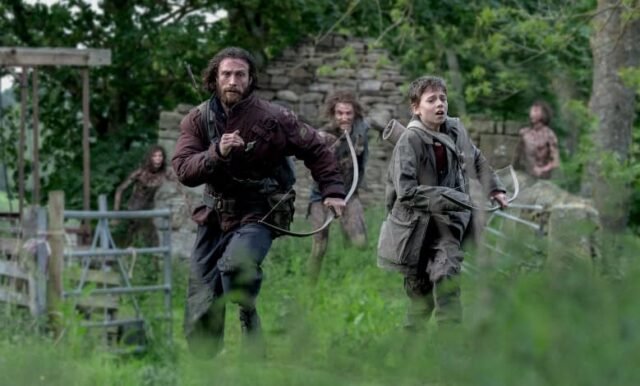It’s hard to believe that the zombies were practically dead before Danny Boyle shocked them back to life.
The director’s “28 Days Later” may have used a “rabies virus” to do the trick in 2002, but it was enough to remind us why these ghouls matter.
And the boy was one of those creeps that eats flesh quickly.
Now, nearly two decades later, Boyle ‘s sequel is back with “28 Years Later.” The math may be confusing, but there’s nothing dull about this exciting update.
“28 Years Later” is a coming-of-age film about life, death, and survival. Oh, and you’ll spend an inordinate amount of time on the edge of your seat.
The film’s prologue pushes the boundaries of horror, even in our “terribly” age. You have been warned.
From there, we pick up in-the-know-how many years later. We meet a family living on an island that seems safe from the zombie hordes that decimated England in the first film.
It’s where Young Spike (Alfie Williams), his father Jamie (Aaron Taylor-Johnson) and their sickly Ma Isla (Jodie Comer) call home.
The island’s residents still rely on the mainland for supplies, and it’s become a rite of passage for teenagers to visit to make their first “kill” (and hopefully stay alive). “28 Years Later” is aggressively awkward in this area. The men do the hunting while the women stay behind and prepare the meals.
Unleashing!
Related: 7 Best Zombie Movies Post ’28 Days Later’
Spike may be 12, but his daddy thinks he’s ready to prove his bowhunting prowess. Is anyone prepared to take on a horde of rage-filled ghouls, particularly the alphas who could fend off a small army? This nightmarish tweak to the zombie genre works beautifully under Boyle’s inspired direction.
The dysfunctional family dynamic can be seen in the film, amidst the edited battles with the undead. Williams delivers a stellar performance, capturing the fear of youth and a growing sense of responsibility.
The boy is desperate to find a doctor for his sickly mother, and when he learns about a mysterious doctor on the mainland, he becomes obsessed with finding him.
“28 Years Later” is sublime and, later, solid. The first half of the film captures the culture of post-pandemic life, from the precautions of everyday life to the shift back to a pre-digital era.
The locals live as if it were medieval times, avoiding modernity in the process. Is there any other choice? It’s still fascinating to watch, granting the sequence a power we didn’t see coming.
That’s where Spike’s family fits into the narrative. Jamie is a dutiful father, but his biological needs confuse and horrify the young Spike. Isla appears to have a form of the rabies virus, but her bouts of clarity suggest she could be saved before the end credits roll.
Boyle and “28 Days Later” writer Alex Garland strike a near-perfect balance between horror and humanity in the first half. Later, the story shifts focus and loses some of what was cleverly established earlier. It’s still captivating and occasionally terrifying.
Ralph Fiennes’ arrival later in the story leaves Spike to learn even more difficult lessons about adolescence in his nightmarish reality.
Director George A. Romero started the modern zombie genre, but his films often portrayed humans as more monstrous than the undead. Boyle and Garland offer something more hopeful without skimping on the scares.
What does it matter?
“28 Years Later” is not a cash-grab sequel, but a thrilling extension of a genre-defining original.
Note : The final sequence is shocking, but hardly in a good way. It’s an obvious nod to the next film in the saga, a move as cynical as Peak MCU Theatrics.
Hit or miss: “28 Years Later” shows director Danny Boyle still knows how to make us squirm without leaving humanity on the cutting room floor.















